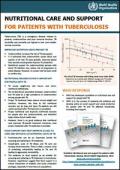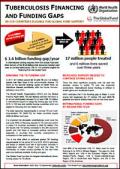What's New
Displaying results 3411 - 3420 of 4922

Resource | Fact Sheets,
Tuberculosis (TB) is a contagious disease related to poverty, undernutrition and poor immune function. TB morbidity and mortality are highest in low- and middle-income countries.
Undernutrition increases the risk of TB. It is estimated that undernutrition causes about one quarter of all new TB cases globally. Improved global food security would greatly improve TB prevention. Nutritional support for undernourished persons with latent TB infection may reduce risk of progression to active disease. However, no proper trial has been done to confirm this.

Resource | Fact Sheets,
In 2011, 8.7 million people fell ill with TB and 1.4 million people lost their lives to this communicable disease. TB ranks as the second leading cause of death from an infectious disease worldwide, after the human immunodeficiency virus (HIV).
It is projected that domestic contributions could cover the bulk (over 65%) of financing required for TB care and control in these 118 countries, equivalent to US$ 3.2 billion. This will require that TB funding increases in line with economic growth and that there is increased political commitment especially in countries that currently underperform in comparison to their ability to pay.
This is the first effort to estimate global TB funding requirements for the period 2014 to 2016. WHO’s estimates are based on detailed work with 9 high-burden countries in collaboration with the Global Fund and the Stop TB Partnership, to review country priorities for the next three years and estimate available funding and gaps. The Global Fund provides the largest international donor funding stream for TB efforts.

Resource | Publications,
The SAARC region has a low level of HIV infection, but the sheer numbers of people living with HIV (PLHIV) is quite high, estimated at 2.57 million, with the largest burden shared by three countries: India 2.4 million, Pakistan 98,000, and Nepal 64,000. The epidemic is concentrated in certain geographical pockets (six states of India, large cities of Pakistan, and large cities and bordering districts of Nepal) and among key affected population, such as sex workers, men who have sex with men (MSM), people who inject drugs (PWID), and transgender people.
The key commitment of the First SAARC Strategy was to urgently scale-up responses towards achieving the goal of universal access to comprehensive prevention, treatment, care and support by 2010. Though there have been significant improvements, these have not been uniform across all countries and there are pockets where HIV prevalence is on the increase. The current strategy is an effort to strengthen the regional responses based on lessons learned from the outcomes of the first SAARC Strategy on HIV/AIDS.

Resource | Presentations,
Presentation presented at 7th IAS Conference on HIV Pathogenesis, Treatment and Prevention Date: 1 July 2013 Place: Kuala Lumpur

Resource | Presentations,
Asia-Pacific Aspirations Perspectives for the Post-2015 Development Agenda in South Asia
Organized by ESCAP/ADB/UNDP regional partnership
20 September 2013 Bangkok, Thailand

Resource | Presentations,
Getting to zero HIV new infections in Asia and the Pacific region: Possible or impossible dream?
Presentation presented at the ICAAP, Bangkok.

Resource | Presentations,
Main outcomes of the consultation
1. Lessons learnt from the health MDGs
2. Health priorities post 2015
3. The role of health in the broader post-2015 development agenda
4. Potential goals and targets
5. Not just "what" – but "how"

Resource | Presentations,
HIV Epidemic and Response in Asia and the Pacific Presentation
Judicial Dialogue on HIV, Human Rights and the Law in Asia and the Pacific
Meeting, 2-4 June 2013 Bangkok, Thailand






